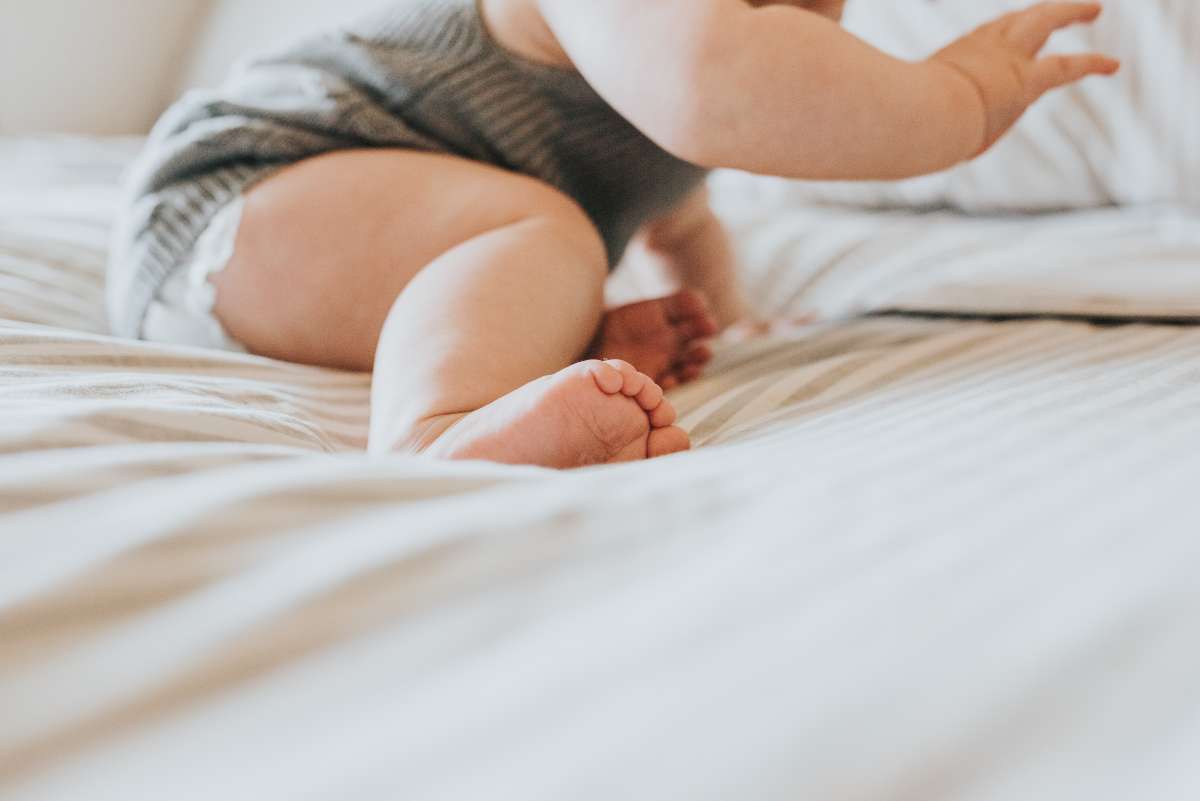When it’s time to sleep at night, you probably don’t just hop into bed in the clothes you wore all day and turn out the light. Whether you realize it or not, you follow a routine — brush your teeth, wash your face, change into pyjamas and maybe read for a little while before lights out. Like you, your baby can benefit from a consistent and predictable bedtime routine.
A baby bedtime routine signals to your little one that it’s time to wind down and sleep. The best routine works with your family's schedule and can be implemented consistently, bridging the transition from a busy day to a quiet night. These moments may become the coziest and calmest you spend with your child every day.
Don't pressure yourself to impose a bedtime routine when you get home from the hospital with your newborn. After all, he has to recover from the effort of being born — and so do you! Plus, newborns don’t have enough of a sense of day and night to have any predictable patterns.
But when your baby is around 6 to 8 weeks of age, you can try starting a bedtime routine. It should be very short at first — maybe just a cuddly feeding and a brief reading of an age-appropriate book.
Bedtime routines reinforce babies’ natural circadian rhythms, helping teach them the difference between day and night. Later on, a baby bedtime routine helps little ones slow down and prepare mentally for bedtime.
A regular bedtime ritual creates a sense of comfort that can be especially helpful during trying sleep periods for you and your baby, such as when you’re sleep training (which you can try between 4 and 6 months old) or when your baby is going through a sleep regression.
A consistent sleep routine helps:
- The baby fell asleep. A calming bedtime ritual that follows a predictable pattern every night gives your baby a heads-up that it's time to wind down and prepare for sleep, which in turn helps him to nod off.
- Set the baby up for a lifetime of good sleep. Sleep regressions — where babies have a hard time falling or staying asleep — are normal throughout the first year. Having a bedtime routine offers comfort that can help your baby get through these phases.
- You can relax. A bedtime routine is a wonderful way to bond with your little one at the end of a long day, and it just might make evenings more relaxing for you, too.
Sleep is undoubtedly one of the bigger challenges of your baby’s first year. But establishing a baby bedtime routine early on will help both you and your baby sleep more soundly for years to come.
FAQs About Baby Bed
The best bedtime routine for baby
- A feed with cuddles. A nightcap fills your baby's tank before the night ahead.
- Books. Settle down into your glider or rocking chair and read a favourite book in a quiet, calm voice.
- Gentle infant massage.
- A soothing bath.
- Lullabies.
- White noise.
- A few parting words.
You may feel ready to introduce a bedtime routine when your baby is three months old. Getting them into a simple, soothing bedtime routine can be a great opportunity to have 1-to-1 time with your baby.
Some sleep experts believe that waking up a baby from sweet sleep is good. So if the baby takes a long nap before bedtime, remember that it's okay to wake her up after an hour or so, especially when it's her last nap. What you don't want to happen is for the baby to get overtired.
Make a bedtime routine and stick to it.
Creating a predictable bedtime routine — which might include bathing your baby, putting on her pyjamas, listening to lullabies and reading a story together — can help signal to your little one that it's time to sleep.
between six pm and eight pm
Bedtimes will vary from day to day and from baby to baby, but you might expect a bedtime for a 4-month-old to be between six pm and eight pm. Be aware of the awake time from the last nap of the day, and don't be afraid to use an earlier bedtime to avoid overtiredness.
The best bedtime routine for baby
There is no one-size-fits-all bedtime routine that works for every baby. Try to be flexible and find what suits both you and your baby. Here's an example of a bedtime routine that works for many families:
- A feed with cuddles. A nightcap fills your baby’s tank before the night ahead. If he has any teeth, brush them (and wipe his gums) when you’re done. And if your baby tends to fall asleep during feedings, push up this part of the routine before the bath.
- Books. Settle down into your glider or rocking chair and read a favourite book in a quiet, calm voice.
- Gentle infant massage. Research suggests that babies who get a rub-down before bedtime produces more melatonin hormone, which helps them sleep.
- A soothing bath. Warm water has sleep-inducing powers. Try incorporating a mild soap or lotion with chamomile or lavender into your baby’s bathtime for extra relaxation. The American Academy of Pediatrics (AAP) doesn't recommend bathing newborns and babies every night, however, because it can dry out their delicate, sensitive skin.
- Lullabies. A soft song or lullaby sets the stage for sleep. Save the tickle monster and other rougher games for earlier in the day.
- White noise. The uterus is a pretty noisy place, between your breathing and gurgling stomach — which is why many infants find white noise or a mobile musical soothing at bedtime.
- A few parting words. Say some comforting, predictable words to your baby before leaving the room, like “Goodnight, I love you,” with a stroke on the cheek and a kiss on the head.
Tips for establishing a baby bedtime routine

Time it right
Keep a log of your baby’s sleep patterns, noting the longest sleep stretch of the night. Remember, you'll be lucky if your baby sleeps five or six hours in a row during the early months.
Get to know your baby’s sleep cues, which often involve rubbing his eyes or yawning, as you’ll want to put your baby to bed when he’s sleepy but not overtired.
As soon as you understand roughly when your baby sleeps for his longest stretch at night, try to time a pre-sleep routine about 30 to 45 minutes before his natural drop-off time. For example, if he tends to sleep his longest stretch from 8 p.m. to 1 a.m., start a bedtime routine around 7:15 or 7:30 p.m.
Put your child to sleep in the same place.
Most babies fall asleep in their strollers or car seats sometimes. Just aim to consistently put your baby to sleep in his crib at around the same time, even for naps, starting when he's a couple of months old. It’s important not only to help your baby sleep more soundly but also to reduce the risk of sudden infant death syndrome (SIDS).
To that end, avoid scheduling errands when it’s baby’s naptime. If your cutie does fall asleep in the stroller, car seat or swing, be sure to transfer him to the crib as soon as possible.
Create the right atmosphere
Dim the lights, pull the shades down or close the curtains, turn off the TV and put away your phone to set a relaxing tone.
Try to master the drowsy baby drop-off.
At the end of your baby’s bedtime routine, put your sleepy little one down while he's drowsy but still awake. That way, he’ll get used to falling asleep on his own, not in your arms.
Indeed, the drowsy baby tuck-in doesn't work for every infant, but it's well worth attempting. If you’re not successful the first few times, keep at it! Eventually, you’ll be rewarded when your baby dozes off all independently.
Adjust as necessary
In the beginning, your baby’s bedtime routine may involve snuggles and a lullaby, followed by a quiet bedtime story, before putting the baby in his crib on the brink of sleep.
Keep in mind that as your baby grows, his needs will change, so try to be flexible and adjust as necessary. For instance, as your baby gets older, bathtime before bed may turn rowdier. Move tub time to earlier in the routine, leaving the more relaxing strategies, like a story or a baby massage, for closer to bedtime.
Keep it consistent
Regularity is an essential ingredient of a soothing bedtime routine. Consistency breeds comfort, which helps lull your baby into a peaceful sleep.
Create a shorter nap routine
Abbreviating your baby’s nighttime routine for a naptime routine helps reinforce his sleep cues to encourage the transition to dreamland.
Naps are shorter than overnight sleep, so your routine can be too. Take advantage of the sleep associations your baby knows — a story or song — and incorporate them into his naptime routine.
Bedtime habits for infants and children
Sleep patterns are often learned as children. When these patterns are repeated, they become habits. Helping your child learn good bedtime habits may help make going to bed a pleasant routine for you and your child.
Information
YOUR NEW BABY (LESS THAN 2 MONTHS) AND SLEEP
At first, your new baby is on a 24-hour feeding and sleep-wake cycle. Newborns may sleep between 10 and 18 hours a day. They stay awake only 1 to 3 hours at a time.
Signs that your baby is becoming sleepy include:
- Crying
- Eye rubbing
- Fussiness
Try putting your baby to bed, sleepy but not yet asleep.
To encourage your newborn to sleep more at night rather than during the day:
- Expose your newborn to light and noise during the daytime
- As evening or bedtime approaches, dim the lights, keep things quiet, and reduce the amount of activity around your baby
- When your baby wakes up at night to eat, keep the room dark and quiet.
Sleeping with a baby younger than 12 months may increase the risk for sudden infant death syndrome (SIDS).
Your Infant (3 To 12 Months) And Sleep
By age four months, your child might sleep for up to 6 to 8 hours at a time. Between ages 6 and 9 months, most children will sleep for 10 to 12 hours. During the first year of life, it is common for babies to take 1 to 4 naps a day, each lasting 30 minutes to 2 hours.
When putting an infant to bed, make the bedtime routine consistent and pleasant.
- Give the last nighttime feeding shortly before putting the baby to bed. Never put the baby to bed with a bottle, as it can cause baby bottle tooth decay.
- Spend quiet time with your child by rocking, walking, or simple cuddling.
- Put the child in bed before he is deeply asleep. This will teach your child to go to sleep on his own.
Your baby may cry when you lay him in his bed because he fears being away from you. This is called separation anxiety. Go in, speak in a calm voice, and rub the baby's back or head.
DO NOT take the baby out of bed. Once he has calmed down, leave the room. Your child will soon learn that you are simply in another room.
If your baby awakens in the night for feeding, DO NOT turn on the lights.
- Keep the room dark and quiet. Use night lights, if needed.
- Keep the feeding as brief and low-key as possible. DO NOT entertain the baby.
- When the baby has been fed, burped, and calmed, return your baby to bed. If you maintain this routine, your baby will become used to it and go to sleep independently.
By age nine months, if not sooner, most infants can sleep for at least 8 to 10 hours without needing a nighttime feeding. Infants will still wake up during the night. However, over time, your infant will learn to self-soothe and fall back asleep.
Sleeping with a baby younger than 12 months of age may increase the risk for SIDS.
Your Toddler (1 To 3 Years) And Sleep:
A toddler will most often sleep for 12 to 14 hours a day. By around 18 months, children only need one nap each day. The nap should not be close to bedtime.
Make the bedtime routine pleasant and predictable.
- Keep activities such as taking a bath, brushing teeth, reading stories, saying prayers, and so forth in the same order every night.
- Choose calming activities, such as taking a bath, reading, or giving a gentle massage.
- Keep the routine to a set amount of time each night. Give your child a warning when it is almost time for lights-out and sleep.
- A stuffed animal or special blanket may give the child some security after the lights are turned out.
- Before turning out the light, ask if the child needs anything else. Meeting a simple request is OK. Once the door has been closed, it is best to ignore further requests.
Some other tips are:
- Establish a rule that the child cannot leave the bedroom.
- If your child starts screaming, shut the door to his bedroom and say, "I am sorry, but I have to shut your door. I will open it when you are quiet."
- If your child comes out of his room, avoid lecturing him. Using good eye contact, tell the child that you will open the door again when the child is in bed. If the child says, he is in bed, open the door.
- If your child tries to climb into your bed at night, unless he is afraid, return him to his bed as soon as you discover his presence. Avoid lectures or sweet conversation. If your child cannot sleep, tell him he may read or look at books in his room, but he is not to disturb other people in the family.
Praise your child for learning to self-soothe and fall asleep alone.
Remember that bedtime habits can be disrupted by changes or stresses, such as moving to a new home or gaining a new brother or sister. It may take time to reestablish previous bedtime practices.
Encouraging good sleep habits

For the first few months, middle-of-the-night feedings will disrupt sleep for parents and babies alike — but it's never too soon to help your baby become a good sleeper. Consider these tips:
- Follow a consistent, calming bedtime routine. Overstimulation in the evening can make it difficult for your baby to settle to sleep. Try bathing, cuddling, singing, playing quiet music or reading, with a clearly defined endpoint when you leave the room. Begin these activities before your baby is overtired in a quiet, softly lit room.
- Put your baby to bed drowsy but awake. This will help your baby associate bed with the process of falling asleep. Remember to place your baby to sleep on their back and clear the crib or bassinet of blankets and other soft items.
- Give your baby time to settle down. Your baby might fuss or cry before finding a comfortable position and falling asleep. If the crying doesn't stop, check on your baby, offer comforting words and leave the room. Your reassuring presence might be all your baby needs to fall asleep.
- Consider a pacifier. If your baby has trouble settling down, a pacifier might do the trick. Research suggests that using a pacifier during sleep helps reduce the risk of SIDS.
- Keep nighttime care low-key. When your baby needs care or feeding during the night, use dim lights, a soft voice and calm movements. This will tell your baby that it's time to sleep — not play.
- Respect your baby's preferences. If your baby is a night owl or an early bird, you might want to adjust routines and schedules based on these natural patterns.
Remember, getting your baby to sleep through the night isn't a measure of your parenting skills. Take time to understand your baby's habits and ways of communicating so that you can help them become a better sleepers. If you have concerns, talk to your baby's doctor.
Conclusion
If your baby tosses and turns all night, reworking their sleep routine might solve the issue. "There's no such thing as a bad sleeper, just bad sleep habits, and they're usually reversible," says Ingrid Prueher, a pediatric sleep consultant in Fairfield, Connecticut, and host of the Baby Sleep 911 video series.
Avoid these common sleep saboteurs, and you may snooze through the night.






